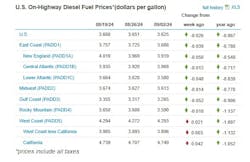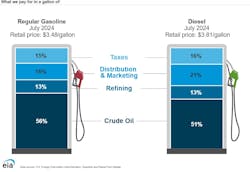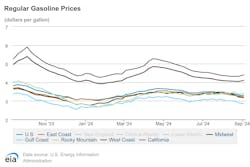National diesel, gas prices continue to drop, West Coast costs increase
While there’s still a few weeks until summer officially transitions to fall, the U.S. Energy Information Administration (EIA) found that fuel prices in a few regions behaved as though cooler weather is already here. While much of summer’s fuel prices, whether gasoline or diesel, were driven by political conflict in the Middle East and slower economic growth and consumption in the U.S. according to Matt Muenster, chief economist at Breakthrough, prices are expected to return to following the seasons over the next few months.
“We still have a seasonal bump built into the diesel refinery premium, or diesel crack, through October, because of the greater amount of freight movements, our movement toward the holidays, and how agricultural production will ramp up that same time,” Muenster explained. “Last year, the price of wholesale diesel went up about a gallon from the end of July through the end of September. But we don't expect anything like that this year.”
An example of this is in areas with higher fuel taxes, where the cycle of fuel prices started to go up. For instance, while the U.S. national on-highway diesel fuel price average dropped 2 cents to $3.625, along the West Coast, prices went up roughly 2-4 cents. The West Coast overall saw a price increase of 2 cents to $4.293, the West Coast without California went up less than a cent to $3.896, and California alone saw its diesel prices go up 4 cents to $4.749 per gallon.
However, the rest of the country isn’t yet following suit. Prices still dropped, albeit the least, in the Midwest, where diesel costs decreased by 1 cent to $3.613. Following that region, the Rocky Mountain area’s diesel costs fell 2 cents to $3.590. On the higher end, the Gulf Coast’s diesel prices dropped 5 cents to $3.265 per gallon, with the New England sub-region dropping the same amount to $3.919 and the Lower Atlantic sub-region falling 4 cents to $3.580.
Despite this movement, the Gulf Coast is still the cheapest place to purchase diesel at $3.265 and California is the most expensive at $4.748.
To compare, the AAA motor club logged the current diesel average at $3.686 per gallon, roughly 6 cent smore expensive than the EIA’s reckoning and 2 cents cheaper than last week’s prices. As with the EIA, the AAA’s prices from this time last year were much higher than this year, with the beginning of September 2023 seeing an average diesel cost of $4.458, 77 cents more expensive than today. This fall in cost is largely due to inventory availability.
Read more: U.S. diesel average reaches $3.65/gal, gas $3.31/gal
“This year, inventories are higher than they were a year ago, and so that price pressure is relieved,” Muenster said.
Diesel prices are also helped by a lack of change in price allocation in a gallon of diesel fuel. Working off a retail price of $3.81/gal. for July 2024 (9 cent smore expensive than June’s assumed retail price), the EIA found that distribution/marketing was the only cost section that increased. The tax allocation remained the same at 16%, or 60 cents per gallon; refining stayed at 13%, or 49 cents; and crude oil prices stayed the same at 51%, or $1.94. Meanwhile, distribution and marketing accounted for 80 cents of the cost of diesel fuel.
Gas reaches prices not seen since February
As Muenster anticipated, gas prices are also starting to show signs of the autumnal price increase, this time with gas prices rising in the Rocky Mountain region and along the West Coast.
“Gasoline is super cyclical,” the chief economist said. “We certainly expect its price premium to decline not too much past the Labor Day holiday for the month of September, because, especially in the United States, we're just not consuming gasoline as we approach that fourth quarter of the year like we had consumed it through summer.”
The national average for U.S. gas prices, according to the EIA, is currently $3.289 per gallon, down 2 cents from last week and 51 cents from this time last year. But to the west, the West Coast overall saw its gas prices rise 5 cents to $4.101, while the Rocky Mountains’ increased 4 cents to $3.401. The West Coast without California saw its gas prices rise 1 cent to $3.762, while California saw the harshest price increase of 8 cents.
Meanwhile, prices still dropped, even if only less than a cent in the Lower-Atlantic sub-region to $3.138 per gallon, and 2 cents along the East Coast to $3.233. Gas prices fell the most for the Gulf Coast, which saw a 5-cent price drop to $2.844, making it the cheapest place for gas. California is still the most expensive.
The AAA logged its gas average at $3.325/gal, a price 2 cents lower than last week and almost 50 cents lower than this time last year. But the motor club is keeping an eye on the weather in the tropics and hoping the tropical storm in the Atlantic won’t increase gas prices, as of August 29, 2024.
“The arrival of September means cheaper winter-blend gasoline is almost here, which always helps take pressure off pump prices,” said Andrew Gross, AAA spokesperson, of how fleets may attempt to manage fuel prices.
This article was originally published on FleetOwner.com.







